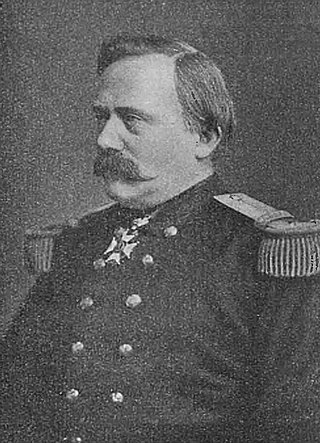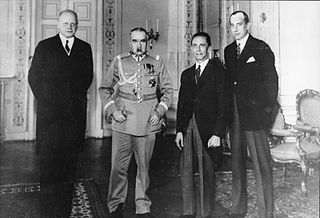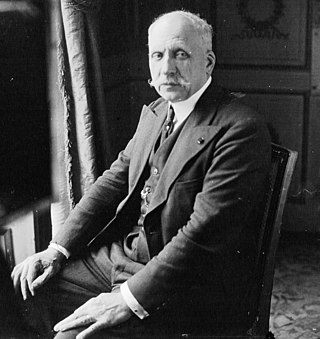
The Maginot Line, named after the French Minister of War André Maginot, is a line of concrete fortifications, obstacles and weapon installations built by France in the 1930s to deter invasion by Nazi Germany and force them to move around the fortifications. It was impervious to most forms of attack; consequently, the Germans invaded through the Low Countries in 1940, passing it to the north. The line, which was supposed to be fully extended further towards the west to avoid such an occurrence, was finally scaled back in response to demands from Belgium. Indeed, Belgium feared it would be sacrificed in the event of another German invasion. The line has since become a metaphor for expensive efforts that offer a false sense of security.

Maxime Weygand was a French military commander in World War I and World War II, as well as a high ranking member of the Vichy regime.

The Locarno Treaties were seven post-World War I agreements negotiated amongst Germany, France, Great Britain, Belgium, Italy, Poland and Czechoslovakia in late 1925. In the main treaty, the five western European nations pledged to guarantee the inviolability of the borders between Germany and France and Germany and Belgium as defined in the Treaty of Versailles. They also promised to observe the demilitarized zone of the German Rhineland and to resolve differences peacefully under the auspices of the League of Nations. In the additional arbitration treaties with Poland and Czechoslovakia, Germany agreed to the peaceful settlement of disputes, but there was notably no guarantee of its eastern border, leaving the path open for Germany to attempt to revise the Versailles Treaty and regain territory it had lost in the east under its terms.

Ferdinand Foch was a French general, Marshal of France and a member of the Académie Française and Académie des Sciences. He distinguished himself as Supreme Allied Commander on the Western Front during the First World War in 1918.
The events preceding World War II in Europe are closely tied to the bellicosity of Fascist Italy, Nazi Germany, Francoist Spain, Imperial Japan, and the Soviet Union, as well as the Great Depression. The peace movement led to appeasement and disarmament.

Maurice Gustave Gamelin was a French general. He is remembered for his disastrous command of the French military during the Battle of France in World War II and his steadfast defence of republican values.

The causes of World War II have been given considerable attention by historians. The immediate precipitating event was the invasion of Poland by Nazi Germany on September 1, 1939, and the subsequent declarations of war on Germany made by Britain and France, but many other prior events have been suggested as ultimate causes. Primary themes in historical analysis of the war's origins include the political takeover of Germany in 1933 by Adolf Hitler and the Nazi Party; Japanese militarism against China, which led to the Japanese invasion of Manchuria and the Second Sino-Japanese War; Italian aggression against Ethiopia, which led to the Second Italo-Ethiopian War; or military uprising in Spain, which led to the Spanish Civil War.

Henri-Alexis Brialmont, nicknamed The Belgian Vauban after the French military architect, was a Belgian army officer, politician and writer of the 19th century, best known as a military architect and designer of fortifications. Brialmont qualified as an officer in the Belgian army engineers in 1843 and quickly rose up the ranks. He served as a staff officer, and later was given command of the district of the key port of Antwerp. He finished his careers as Inspector-General of the Army. Brialmont was also an active pamphleteer and political campaigner and lobbied through his career for reform and expansion of the Belgian military and was also involved in the foundation of the Congo Free State.
The Franco-Polish Alliance was the military alliance between Poland and France that was active between the early 1920s and the outbreak of the Second World War. The initial agreements were signed in February 1921 and formally took effect in 1923. During the interwar period the alliance with Poland was one of the cornerstones of French foreign policy.

The German–Polish declaration of non-aggression, also known as the German–Polish non-aggression pact, was an agreement between Nazi Germany and the Second Polish Republic that was signed on 26 January 1934 in Berlin. Both countries pledged to resolve their problems by bilateral negotiations and to forgo armed conflict for a period of 10 years. The agreement effectively normalised relations between Poland and Germany, which had been strained by border disputes arising from the territorial settlement in the Treaty of Versailles. The declaration marked an end to an economically damaging customs war between the two countries that had taken place over the previous decade.

The Koningshooikt–Wavre Line, abbreviated to KW Line and often known as the Dyle Line after the Dijle (Dyle) river, was a 60 kilometres (37 mi)-long fortified line of defence prepared by the Belgian Army between Koningshooikt and Wavre which was intended to protect Brussels from a possible German invasion. Construction on the KW Line began in September 1939 after World War II had begun but while Belgium itself remained a neutral state. It was subsequently extended southwards from Wavre towards Namur. The line itself consisted of bunkers, anti-tank ditches, and barricades including so-called Cointet-elements and played a key role in Allied strategy during the German invasion of Belgium in May 1940. However, its role in the actual fighting was ultimately minimal. In 2009 an inventory of surviving emplacements was begun.

The remilitarisation of the Rhineland began on 7 March 1936, when military forces of Nazi Germany entered the Rhineland, which directly contravened the Treaty of Versailles and the Locarno Treaties. Neither France nor Britain was prepared for a military response, so they did not act. After 1939, commentators often said that a strong military move in 1936 might have ruined the expansionist plans of Adolf Hitler, the dictator of Germany. However, recent historiography agrees that both public and elite opinion in Britain and France strongly opposed a military intervention, and neither had an army prepared to move in.
The Franco-Soviet Treaty of Mutual Assistance was a bilateral treaty between France and the Soviet Union with the aim of enveloping Nazi Germany in 1935 to reduce the threat from Central Europe. It was pursued by Maxim Litvinov, the Soviet foreign minister, and Louis Barthou, the French foreign minister, who was assassinated in October 1934, before negotiations had been finished.

The Occupation of the Rhineland placed the region of Germany west of the Rhine river and four bridgeheads to its east under the control of the victorious Allies of World War I from 1 December 1918 until 30 June 1930. The occupation was imposed and regulated by articles in the Armistice of 11 November 1918, the Treaty of Versailles and the parallel agreement on the Rhineland occupation signed at the same time as the Versailles Treaty. The Rhineland was demilitarised, as was an area stretching fifty kilometres east of the Rhine, and put under the control of the Inter-Allied Rhineland High Commission, which was led by a French commissioner and had one member each from Belgium, Great Britain and the United States. The purpose of the occupation was to give France and Belgium security against any future German attack and serve as a guarantee for Germany's reparations obligations. After Germany fell behind on its payments in 1922, the occupation was expanded to include the industrial Ruhr valley from 1923 to 1925.

Belgium was not a belligerent in the Franco-Prussian War (1870–1871), as the country was neutral throughout the war, but was heavily influenced by the social and political effects of the conflict. An invasion of Belgian territory by either side was widely feared in 1870 and the Belgian Army was mobilised. The inadequacies which this revealed in Belgium's military and defensive preparations led to calls to reform the system of conscription and for a programme of fortification-building which would greatly influence the early phases of World War I.

The Rio Nuñez incident or Rio Nuñez affair was an international incident in 1849 on the Nunez River near Boké, in modern-day Guinea. The incident occurred as a result of a local power struggle in which vessels of a joint Belgian and French naval force fired on an enemy village, which resulted in inventory losses incurred by two British traders.

Louis Félix Thomas Maurin was a French army general who was twice Minister of War in the 1930s. Before and during World War I (1914–18) he was a strong advocate of motorization. In the inter-war period from 1919 to 1939 he advocated a policy of passive defense against the growing German threat. He thought that with all the money that had been spent on the Maginot Line fortifications it would be madness to go on the offensive. He saw little value in tanks as a weapon. He advised against a limited military reaction when Germany reoccupied the Rhineland in March 1936, calling for general mobilization or nothing. He did not consider that the 1936 pact with Russia would help France militarily.
The Bérard-Jordana Agreement, also called Berard-Jordan Agreement in English, was a political treaty signed by France and Spain in Burgos on 25 February 1939. Its name is based on the two principal signatories, Léon Bérard for France and General Francisco Gómez-Jordana Sousa for Spain.

Charles Henri Raymond Brugère was a French diplomat.
France and the League of Nations was a major theme of French foreign policy in the 1920s and 1930s. France and the United Kingdom were the two dominant players in world affairs and in League affairs, and usually were in agreement. The League proved ineffective in resolving major problems. In 1945 it was replaced with the United Nations, where France played a major role despite its much weaker status. However in the 1920s and 1930s the main themes of French foreign policy focused on defense against Germany, and took place outside of League jurisdiction.















